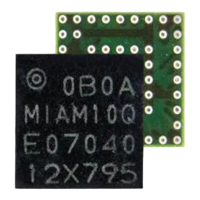
Do you have a question about the Ublox MIA-M10Q and is the answer not in the manual?
| Brand | Ublox |
|---|---|
| Model | MIA-M10Q |
| Category | Control Unit |
| Language | English |
Provides an overview of the MIA-M10Q receiver, its features, and capabilities.
Details the receiver's internal architecture and processing capabilities.
Lists and describes the pinout of the MIA-M10Q module.
Explains the mechanism for configuring receiver features using UBX configuration keys.
Summarizes commonly used basic receiver configuration settings.
Presents configuration options for the navigation engine, including dynamic platforms and filters.
Describes configuration options for UART, I2C, and PIO communication interfaces.
Explains configuration for controlling active antennas and detecting faults.
Explains the use of SBAS and QZSS SLAS for correction data.
Describes the Universal Asynchronous Receiver/Transmitter (UART) interface and its configuration.
Details the Inter-Integrated Circuit (I2C) interface and its operation in slave mode.
Explains the General Purpose Input/Output (PIO) pins and their various functions.
Explains the antenna supervisor feature for managing active antennas and detecting faults.
Details how to lock receiver configuration to prevent unauthorized changes.
Describes continuous mode for signal acquisition and tracking.
Explains Power Save Mode (PSM) for reducing system power consumption.
Explains inactive states for reduced power consumption.
Explains how the receiver maintains its local time.
Details the various GNSS time bases and UTC variants supported.
Explains accurate time measurement using external interrupt pins.
Describes the time pulse feature with configurable duration and frequency.
Discusses maintaining accurate time for receiver performance.
Explains how the protection level quantifies position reliability.
Provides an overview of A-GNSS protocol and AssistNow services.
Explains the data batching feature for storing and retrieving position fixes.
Describes the CloudLocate service for remote position calculation.
Details the MIA-M10Q's power supply pins and requirements.
Explains the real-time clock (RTC) for maintaining time during power-off.
Discusses GNSS signal susceptibility to RF interference.
Describes the receiver's RF front-end design for sensitivity and immunity.
Discusses PCB layout considerations for optimal GNSS performance.
Describes the module's package footprint and solder mask recommendations.
Covers ESD precautions and general safety for module handling and operation.
Describes module packaging, reels, and moisture sensitivity levels.
Details soldering procedures, inspections, rework, and ultrasonic process warnings.
Discusses migration from u-blox M8 to MIA-M10Q.
Summarizes key software-related changes between M10 and M8.
Provides reference designs for typical and antenna supervisor setups.
Lists recommended external components for reference designs.
